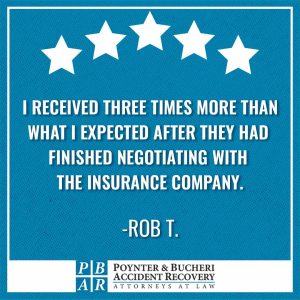
A hit and run accident occurs when a driver hits another vehicle, property, a pedestrian, or a bicyclist and immediately flees the scene without leaving behind any information or offering to help. In some cases, the guilty driver may get out of their car to initially inspect the damage before driving away, but they most often drive off before anyone can identify them or call the authorities. That is when you need to call an Indianapolis hit and run attorney.
At Poynter & Bucheri, we are experienced hit and run accident lawyers who have the experience in Indiana law to make sure that you get a fair settlement if you have been the victim of a hit and run accident. A hit and run attorney knows the ins and outs of auto insurance policy and the legal process to help you collect compensation and press criminal charges if necessary.
Compensation from a Hit and Run Accident

Recovering compensation after a hit and run collision can be a challenge. If you pursue a personal injury claim, you will need to be able to find the hit and run driver and prove fault for them to be held liable and responsible for paying your compensation.
If authorities cannot identify and track down the at fault driver, your other option is to pursue compensation through your own insurance policy.
However, that insurance coverage may not give you the maximum compensation possible. To recover compensation from the other driver, they must be identified for the hit and run accident.
An Indianapolis hit and run accident attorney can help you explore the option of your insurance coverage and even underinsured motorist coverage insurance policies to help compensate you for financial losses. An experienced attorney in hit and run accidents will also know what steps to take to identify you and find the other driver with a supporting legal team.
Steps to Take After a Hit and Run Accident
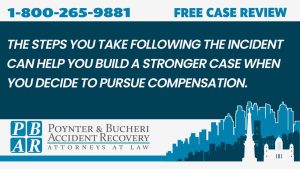
As the victim of a hit and run accident, you should never leave the scene. The steps you take following the incident can help you build a stronger case when you decide to pursue compensation.
Following a hit and run accident, you should:
Stay Where You Are
Do not attempt to go after the driver involved who has left the hit and run accident, as this could negatively impact your claim. It could also put you at risk of additional bodily injury.
Call 911 Immediately

A police report should be filed with as much information and details as you can remember to help them catch the suspect and press criminal charges. Be sure to have them send emergency medical responders as well to treat your injuries, as well as medical attention for any other injured victims.
Gather Contact Information
Gather as many witness statements as possible after the at fault driver leaves the scene. Eyewitnesses can be highly beneficial in criminal cases when authorities are attempting to identify the guilty driver and press a criminal charge. The witnesses can also provide testimony in an injury claim should the insurance company try to deny coverage.
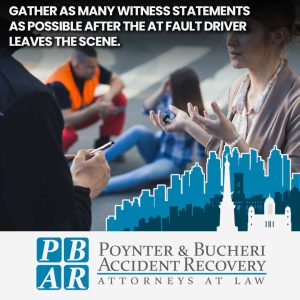
Take Photos of the Scene
Photographic evidence is also very helpful in criminal and personal injury cases for hit and run collisions. Take photos of your injuries, damage to your car, damage to other property, and photos of the scene as a whole.
Seek Medical Attention
After the hit and run accident, if you were not immediately taken to the hospital by emergency responders, you should see your doctor for treatment of any potential injuries. It is always best to seek treatment after a hit and run accident as soon as possible to avoid further injury. Medical documents and doctor testimonies can also help support a personal injury claim.
Write Down as Much as You Can Remember About The Hit and Run Driver
Following the accident, it’s in your best interest to write down every detail about the hit and run driver that you can remember. Even though you may have already given a statement for the police report, you may remember more details about the car accident once the shock of the accident wears off. It’s important for your accident lawyer to have all the information possible when you seek compensation.
Report the Accident to Your Car Insurance Company
While the police will handle the criminal investigation once the driver fled the scene, your insurance will be responsible for handling your accident claim to help you get coverage for your injuries and any damage to your car. The hit and run driver involved should be responsible for your medical bills, but if they can’t be found, your hit and run accident lawyer can use the report during a free case review.
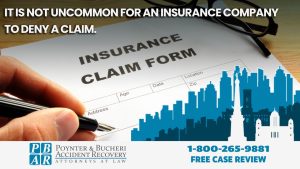
Contact an Attorney
It is not uncommon for an insurance company to deny a claim. It is crucial in Indianapolis hit and run accidents situations to work with an accident lawyer who knows how to fight back to get you the compensation you deserve.
An Indianapolis hit and run lawyer will also be experienced in specific Indianapolis hit and run laws. Call our firm today at 1-800-265-9881.
Why Do Drivers Flee the Scene?

There are any number of reasons why hit and run drivers may flee car accidents before they can be held liable. Typically, it is because they fear the consequences and don’t want a felony or Class B misdemeanor on their record.
Some at fault drivers in a car accident will even leave an unattended vehicle at the scene and race away rather than immediately stop and take responsibility for the hit and run. Your hit and run accident lawyer can support you while dealing with their insurance company or your own agency on a contingency fee basis.
The most common reasons people have for fleeing the accident scene after hit and run accidents include the following:
- They are uninsured
- They are driving without a license
- They were driving a stolen or borrowed car
- They were driving while intoxicated
- They are in possession of illegal substances
- They have a prior criminal record
- They can’t afford legal fees
- They fear going to jail
- They fear getting a ticket
Proving Fault in a Hit and Run Accident
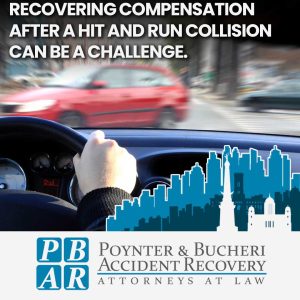
According to Indiana code and state law, if the guilty hit and run driver is identified, even if they fled, they are responsible for paying your claim through their insurance company or out of pocket. If the accident results in bodily injury or an injured person, they may be guilty of a felony.
Unfortunately, even in these cases where the accident involves serious bodily injury, their insurance company may try to deny fault or contend that you were partially responsible. In this situation, your hit and run accident lawyer can work with you to gather the necessary information and evidence to prove fault and cover your medical expenses and property damage.
Evidence that can be used to establish fault and give you reasonable assistance against a hit and run driver can include:
- Photos or video surveillance from the accident scene
- Eyewitness testimonies
- Physical evidence from the scene, such as the vehicles or property that was damaged
- Medical records
- Physician statements
- The police report
In some cases, accident reconstruction experts or engineers may be brought in to help with the case. They may use diagrams or models of the accident scene to help show how the accident occurred and who was at fault.
Injuries from Hit and Run Accidents
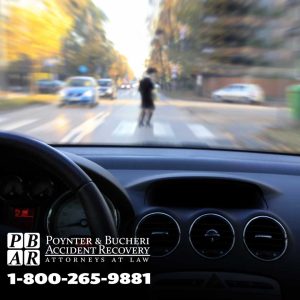
Hit and run accidents are incredibly frustrating and even traumatizing.
Not only are you potentially left with severe injuries and medical bills, but you may also be left without answers or justice if the negligent driver cannot be found.
You can experience lost wages or lost income while you deal with a severe injury, combined with the emotional trauma of the event.
Whether you have bills that need to be paid or non economic damages, a hit and run accident lawyer will be able to help.
Contact Poynter & Bucheri Indianapolis Hit and Run Attorneys
If you or a loved one are involved in a hit and run accident, you need a hit and run accident lawyer from the Poynter & Bucheri law office. We offer a free consultation, which includes an explanation of your legal rights, a discussion of your options, and our legal opinion of your claim based on years of experience handling car accident claims in Indianapolis.
If you have been injured in an accident, call our law firm today at 1-800-265-9881 for a free case review.
